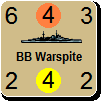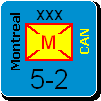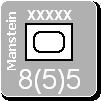Warspite 1ORIGINAL: Ohio Jones
ORIGINAL: brian brian
The HMS Prince of Wales carried Churchill to Newfoundland to meet Roosevelt, I believe.
Correct. Its tragic end off Indonesia (IIRC) would put the final nail in the coffin for BB actions without air cover. Should be an interesting counter description in MWF.
This is the draft for the counter - still needs some work but this is the outline
4590 Prince of Wales
.B Engine(s) output: 125,000 hp
.B Top Speed: 29.5 knots
.B Main armament: 10 x 14-inch (356mm), 16 x 5.25-inch (133mm) DP guns.
.B Displacement (Full Load): 40,990 tons
.B Thickest armour: 15-inches (belt)
.P The five King George V battleships (KGV`s) were the penultimate class of
battleship built for the Royal Navy (RN). The Second World War was to show that
battleships were simply too costly and too vulnerable to attack from the air or
by submarine and by the middle of World War II, the aircraft carrier had
overtaken the battleship as the primary ship of the fleet.
.P The lead ship, King George V was completed in late 1940. As the latest RN
battleship why did she seemingly not compare in main armament with the Bismarck
or the North Carolina classes? The reason was that the KGV`s were designed in
line with the 1935 Naval Limitation Treaty. When Japan subsequently failed to
ratify the treaty, the first two ships were already being built with 14-inch
main armament and this could not be changed without severely delaying their
introduction. However to guard against possible non-ratification of the treaty,
the KGV`s were designed to withstand 16-inch shells and so in many respects were
better protected than their contemporaries.
.P In addition, the 14-inch guns were not necessarily at a disadvantage compared
with the eight 15-inch guns that the Bismarcks for example offered. The KGV`s
shells could still penetrate most armour. Their ten guns could fire larger
salvoes - ten shells against Bismarck`s eight - and as a result, increase their
hit probability. The potential downside was their lower range, particularly in
clear weather.
.P Overall, the KGV`s were well designed ships that gave good service in action
against the enemy, although the 14-inch gun could be prone to mechanical
problems on occasion. Their anti-aircraft (AA) weaponry was adequate and was
increased significantly as the war progressed. The one loss suffered by the
class was that of the Prince of Wales. This loss made perfectly clear that even
the most modern battleship was at a disadvantage against a concerted attack by
aircraft.
.P In August 1940, whilst fitting out, Prince of Wales was hit by bombs during
an air raid on Liverpool and this delayed her completion. She was finally
completed in March 1941.
.P In May, Prince of Wales - still with many civilian shipyard workers aboard as
she had yet to complete her work up - joined the battlecruiser Hood to try and
intercept the German battleship Bismarck and her heavy cruiser escort Prinz
Eugen. The German ships were attempting to break out into the North Atlantic but
had been spotted in the Denmark Strait by the cruisers Suffolk and Norfolk. On
the 24th May, the Hood and Prince of Wales engaged the German ships. Tragically,
a shell penetrated the Hood`s magazine and she blew up taking all but 3 of her
crew of over 1400 men to the bottom. Following the sinking, Prince of Wales
disengaged having received seven hits. However she had scored three hits on
Bismarck, one of which hit a forward fuel tank which forced the Bismarck to head
for France for repairs. Prince of Wales returned to port for repairs and so left
the destruction of the Bismarck to other ships of the Home Fleet, including her
sister ship King George V (see HMS Hood and HMS KGV for more detail).
.P After completion of repairs in August, Prince of Wales carried Winston
Churchill across the Atlantic for a high level meeting with the American
President Roosevelt, during which the Atlantic Charter was signed. Upon her
return to the UK, Prince of Wales was sent for a refit [to upgrade her radar ?]
equipment. Then in September, she was deployed in the Mediterranean on convoy
escort where she assisted a Malta relief convoy - Operation Halberd - for the
first and only time (see HMS ? ).
.P She was back in the UK by the beginning of October. Due to the worsening
outlook in the Far East, and the increasing likelihood that Japan would enter
the war, an argument had been taking place between the Admiralty and the Prime
Minister about the naval contribution in this region. The Admiralty wanted a
steady build up of a Far East Fleet based in Colombo as ships became available.
Winston Churchill wanted a small well armed force to go immediately to
Singapore. With the situation continuing to deteriorate, the Prime Minister won
the argument and Force Z - containing just the Prince of Wales and the old
battlecruiser Repulse - was sent to Singapore, arriving on 2nd December. The
hope was that this Force would act as a deterrent to any Japanese aggression.
It was meant to contain the new aircraft carrier Indomitable but she had run
aground off Jamaica during her work-up trials and at the time Force Z left port
for the last time, she was still on her way to the Far East. This left the Force
wholly dependent upon land based air support should the Japanese decide on war.
The problem was that not only were the RAF numbers in Malaya less than that
considered necessary to defend the colony, but the aircraft that were there were
distinctly second rate. The British hoped to be able to increase the size of
Force Z with the heavy cruisers HMAS Sydney and Exeter. However, Exeter was too
far away on convoy duty to reach Singapore in time and Sydney had been sunk
during an engagement with the German raider Kormoran. The RN did have three
D-class light cruisers at Singapore but there was no question of using these
elderly ships. The only other ship at Singapore was the modern light cruiser
Mauritius but she was under-going refit and would not be ready for some time.
When the Japanese entered the war on 7th December, the British colonies of
Malaya and Singapore were amongst the first targets. The RAF numbers were soon
depleted further as the Japanese overran the northern airfields in Malaya.
.P To protect their invasion fleet the Japanese had four lines of defence. The
main Japanese fleet units were involved in the Pearl Harbour operation and the
ships available to cover the invasion fleet were limited to just six heavy
cruisers as close support and the battleships Kongo and Haruna as distant cover.
Just before the outbreak of war, the Japanese had laid a minefield between
Singapore and the proposed landing beaches. They also placed a number of
submarines behind the minefield. As additional protection they had the 22nd Air
Flotilla based in Indo-China. All this, the British knew via intelligence
reports. The Commander of Force Z, Admiral Tom Phillips had a far from easy
decision to make now that the war had actually started. Doing nothing was not
really an option given the fact that the Malayan campaign was proceeding
perfectly from the Japanese viewpoint. He could stay in port and wait for
reinforcements. The problem here of course was that a Pearl Harbour type raid
could be launched that would destroy his fleet anyway. Phillips decided to
try to intercept the enemy landing fleets in northern Malaya and so the Prince
of Wales, Repulse and four destroyers, Electra, Express, Tenedos and HMAS
Vampire left Singapore and sailed to meet their fate. They sailed on a north
easterly course in order to sail around the minefield. A few hours into the
journey, a message was received from Singapore that confirmed to Phillips that
there would be no fighter cover available to the fleet on the 10th, the date
that Phillips estimated he would make contact with the enemy. Despite this,
he decided that so long as he could maintain the element of surprise, then
Force Z would continue North. During the initial part of the journey the poor
weather favoured the British and kept Japanese reconnaissance aircraft from
spotting their progress. When they were finally spotted, it was a submarine, not
an aircraft that found them. I.65 was the most easterly placed of the Submarine
screen and she spotted the British ships in mid-afternoon on the 9th December.
The submarine was then able to tail the British ships and get off a report of
the sighting before losing contact in a rain squall. Though unaware of this
development, this would be a cruel blow for Phillips. Earlier that day, Japanese
reconnaissance aircraft over Singapore harbour had mistakenly reported that the
British ships were still in harbour. As a result and thinking there was no
threat, the Japanese ordered the cruiser escorts in the north back to Indo-
China. These vessels would be in the path of the British ships intended route.
However, this story would take a further twist or two yet.
.P Just before nightfall, the British were spotted by three Japanese scout
planes. Phillips was in no doubt he had been spotted and now had a hugely
important decision to make. He detatched the destroyer Tenedos - whose fuel
capacity was becoming something of a liability - and sent her south. Despite
having been spotted, Phillips did not immediately turn his five remaining ships
around. Then, from the Electra, a flare was seen in the distance. Phillips now
decided that to continue was folly and turned south. The flare was in fact from
a Japanese bomber that had come across the cruiser Chokai - just five miles from
Force Z - and was trying to lead other aircraft to her. Fortunately for the
Japanese the Chokai was unharmed but the search mission in the darkness was
called off and the Japanese cruisers retired north. However, having began to
head for home, Phillips then received a report from Singapore that the Japanese
were assaulting Kuantan, half way down the Malay Peninsula. Realising that this
could cut the British land forces in two, Phillips ordered Force Z to alter
course and head south west for Kuantan. During all of this time Phillips refused
to break radio silence and believed that air cover would be available for his
ships when he reached Kuantan. Meanwhile, once again a Japanese submarine had
sighted the British but for some reason the message that they had changed course
and were now headed for the Malay coast, did not reach Saigon. In the early
hours of December 10th, Force Z were able to reach Kuantan without incident. The
only trouble was that there were no Japanese anywhere in sight. The report
proved to be false - there was no landing.
.P The 94 aircraft of the 22nd Air Flotilla was now to make its appearance. The
Flotilla had a mixture of nine reconnaissance planes, fifty-one torpedo and
thirty-four level bombers and the first of the squadrons set out for where they
thought the British would be, early that morning. The first wave of nine bombers
came across the Tenedos and duly attacked her. None of the bombs hit and the
bombers withdrew to Saigon. Then one of the reconnaissance planes finally
spotted Force Z and the Japanese in the air were sent in to attack. The
remaining aircraft of the Flotilla would reach the battle zone in essentially
two further groups. As the first wave began their approach, Phillips
inexperience of air attack came into play. Instead of allowing each ship freedom
of manoeuvre, he ordered all ships to turn and this negated much of the initial
AA fire which caused limited damage to the enemy. The first target was Repulse.
However, she took one hit near her hangar and the fires that were started were
soon extinguished. Phillips quickly learned from his mistake and freedom of
manoeuvre was given to all ships - however radio silence had not been lifted.
Ten minutes after the first attack the second came, with Prince of Wales as the
target. Nine aircraft launched a torpedo attack that effectively ended any
chance of the battleship surviving. One incredibly unlucky torpedo hit had
damaged the propeller shaft and the damage in this most vulnerable of positions
had caused major flooding in the vital machinery spaces. The ship took on a huge
volume of water causing a serious list and reducing her speed to around 15
knots. In addition and possibly the most important blow was that much of her
power supply failed and this meant that her ability to fire her AA weapons was
much reduced.
.P The Repulse was now the target of two waves of torpedo bombers and one
squadron of level bombers. Captain Tennant managed to skilfully avoid all of
them - some reports indicate she avoided as many as nineteen torpedoes. In doing
so she was now about three miles away from Prince of Wales and she turned back
towards the crippled Flagship. There was a lull in the battle now that was to
last about 20 minutes before the next wave of Japanese arrived. Incredibly there
was still no signal from Phillips to Singapore requesting air cover and it was
left to Captain Tennant to request this. The RAF had set aside an Australian
squadron of Buffalo aircraft but they had sat idle as radio silence had been
maintained. Now, they were to take off in response to Tennant`s signal but would
not reach the target area until the battle was over.
.P In the meantime the temporary lull was over as the next Japanese attack was
about to start. This was to be another torpedo attack and Prince of Wales was
the first target. Unable to steer and with little AA defence left available, the
attack was devastating. She was struck by four torpedoes and she began to sit
ever lower in the water. Repulse was then subjected to a more concerted attack
from both directions at once which meant that she could not hope to evade all
the torpedoes fired at her. She was hit by five torpedoes, giving her no chance
of survival and she started to sink. Further level bomber attacks were made on
Prince of Wales and less than an hour after Repulse had slid beneath the waves,
the battleship also sank taking with her Admiral Phillips and her Captain John
Leech. The Prince of Wales lost 327 men. Despite the risk that the Japanese
would return, the three accompanying destroyers did not leave their colleagues
and this no doubt saved a great many lives.









